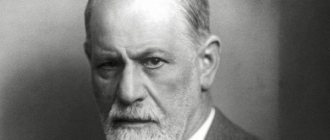The social nature of a person determines his ability to live in society and be part of it. The personality structure as such and the totality of the individual characteristics of a particular person provide him with the opportunity to be a subject of the sociocultural life of society.
Psychologists differ in their views and ideas about the content of the concept of “personality” and about the structure of personality. However, there are many very interesting theories that allow us to better understand the social nature of man and the peculiarities of the functioning of his psyche.
Psychoanalysis: the two-faced sphinx
Freud's theory of personality development formed the basis of many psychological movements of our time. Freud was born more than 160 years ago. But it is almost impossible to look at his works with a modern eye and give them even an unambiguous assessment. Another outstanding person, Charles Darwin, published his fundamental work “The Origin of Species” in 1859. Freud was only three years old at the time. But if Darwin's work determined the thinking of all subsequent generations (not counting believers radically opposed to his theory), then with the adoption of Freud's views the situation is completely different.
Opinions about his theory differ so much that a compromise is almost impossible to establish. Adherents of Freud's views consider him an outstanding scientist. They see his merit in the fact that he was able to see obvious facts that for some reason remained incomprehensible to other psychologists. There is another category of scientists - those who consider him not only lost among his own fabrications, but also regard Freud as a fraudster and a liar. Which side to take regarding the psychoanalysis discovered by Freud - everyone is free to decide for themselves.
Darwin's concept is not subject to such harsh criticism as Freud's theory of personality development. After all, there is a lot of evidence in its favor. In the scientific world, it has long been considered generally accepted, not counting some fanatics who are trying to push religious views into the sphere of science. But the arguments of psychoanalysis are often difficult to understand. The human mind resists all the evidence that Freud provides in his writings.
Representatives of psychoanalysis
Personality psychoanalysis quickly became a popular field. Many psychologists began to develop this direction, expanding and transforming it.
Sigmund Freud is the founder of psychoanalysis.
- Carl Gustav Jung was for some time a student and admirer of Freud's work. The main reason for the discord between scientists was the divergence of views on the action of sexual impulses. Jung argued that their role was unimportant, as his teacher said.
After a quarrel with Freud, Jung began to develop analytical psychoanalysis. He believed that the unconscious is shaped by the memory of ancestors and the influence of society. Unlike Freud, he minimized the role of repressed stimuli. In the process of creating the theory of analytical psychoanalysis, he distinguished the personal unconscious and the collective. The latter presupposes extensive knowledge about the traditions, values and creeds of the people.
Jungian psychoanalysis complements Freud's psychoanalysis and expands its boundaries to the study of society.
- Alfred Adler, while studying neuroses, highlighted the idea that shortcomings become the cause of development and anxiety for a person. A person, realizing his shortcomings, feels his inferiority. This creates in him a constant feeling of anxiety about his skills, abilities and capabilities. At the same time, the urgent need to overcome them allows us to develop through the search for new solutions. From this arise social interests and aspirations.
- Eric Berne studied the human self. He determined that the Self can be in three states. In the “parent” state there is a defining tendency towards necessary actions. The word “must” becomes leading and index.
- In the “child” state, desires are the main thing. This is a state of carefree, good mood and positive outlook on life.
- The “adult” regulates the two previous states, in a timely manner and depending on the situation.
For a person, all states are characteristic as a given. It is quite normal to have an “adult”, a “child” and a “parent” within us. The situation becomes problematic if one of the conditions occurs at the wrong time. For example, in a situation that requires taking responsibility, a “child” may become involved with a reluctance to do so.
- Eric Fromm is considered the founder of neo-Fredism, which developed in America. He believed that psychoanalysis lacked a humanistic tendency. In his opinion, a person is influenced by trends in economics, politics, and religion. Therefore, within the framework of neo-Freudianism, attention is first paid to understanding the environment in which the client lives and what his interests depend on.
An important postulate in the teachings of Eric Fromm is the idea of creating a healthy society. The scientist believed that through such a society a person would be able to gain useful connections with nature and the people around him.
- Karen Horney, within the framework of psychoanalysis, has developed the basic strategies that a person uses in behavior. In her opinion, they help resolve the conflict between human desires and the boundaries of what is permitted. Focus on society. This is a strategy for human interaction. It is used by people with a compliant personality type. This is how people are inclined to communicate and are ready to compromise.
- Anti-society orientation. Strategy of a hostile personality type. For them, the outside world looks like an arena where there is a struggle for the best place. They themselves are also determined to gain better positions.
- Refusal to interact with society. This strategy is important for an isolated personality type. In their understanding, avoiding problems is one of the options that helps get rid of any disturbing stimuli.
Freud and his brainchild
However, even those specialists who disagree with the main tenets of Freudianism must recognize the enormity of his contribution - regardless of how many theses in Freud's works require verification and addition. After all, it was he who was the first to manage to study in detail and as honestly as possible the “animal called man.” Freud openly admitted that every person has to face the same question - how to live in civilization. After all, it is both the most amazing achievement of humanity and its colossal tragedy.
Civilization requires everyone to restrain their desires and passions. Freud did not wear “rose-colored glasses” - he looked soberly at how a person lives under these restrictions. It was Freud who first noted the negative aspect of upbringing and education. Adults dictate to the child what he can do and what he cannot even imagine. Despite the fact that Freud methodically destroyed all his biographical notes and letters, he was always ready to try on his own theory of psychoanalysis.
The scientist noted that very few people are able to openly admit such things that do not leave their reputation unnoticed. Therefore, often, while recording his most revealing dreams and difficult childhood memories, Freud often repented of such self-exposure. “Those who want to reproach me for such secrecy, let them try to be more frank than me,” the scientist wrote.
What areas of psychoanalysis exist today?
There are significant differences between Freud's theories and modern psychoanalysis Safran JD Psychoanalysis Today. Psychology Today. . For example, Ackerman CE Psychoanalysis: A Brief History of Freud's Psychoanalytic Theory is not being done in psychology today. Positive Psychology. such a strong emphasis on sex and related behavior. But at the same time, much attention is still paid to the experience of early childhood.
In the second half of the 20th century, Ackerman CE Psychoanalysis: A Brief History of Freud's Psychoanalytic Theory called for the concept of psychoanalysis. Positive Psychology. French psychoanalyst Jacques Lacan returned, offering a new reading of it. He took a different look at the unconscious and, unlike the founder of psychoanalysis, paid more attention to language.
Lacan came to the conclusion that it is the real, and not the unconscious, that must be recognized as the main level of the human mind. Anxiety, according to Lacan, arises from the fact that a person cannot control the reality around him.
Since psychoanalysis had a huge impact on popular culture, some leading representatives of neo-Freudianism (Jacques Lacan, Slavoj Zizek) conduct Elkan O. B., Putra V. A. The influence of psychoanalysis on the cinema of the twentieth century. Bulletin of Tomsk State University. Cultural studies and art history. psychoanalytic research on her works. For example, one of Žižek’s books is called “What You Always Wanted to Know About Lacan (But Were Afraid to Ask Hitchcock).”
As another example of a neo-Freudian concept, Brenner GH What Is Psychoanalysis? Psychology Today. give interpersonal psychoanalysis. He is associated with the names of such researchers as Harry Stack Sullivan and Erich Fromm. They assign a special place in the development of personality to the child’s environment: parents and other people, especially peers.
Another modern direction of Freudian theory is neuropsychoanalysis Psychoanalysis. Psychology Today. . He seeks to combine psychoanalytic concepts with the advances of neuroscientists in the study of the human brain. In this way, researchers are trying to find the basis of emotions, fantasies and the unconscious.
Freud's childhood and personality formation
A little biography
Freud was born on May 6, 1856 in the city of Freiburg in Moravia. The parents of the future father of psychoanalysis were Jews. Mother, Amalia Nathanson, was the second wife of Jacob Freud, who traded wool and fabrics. In 1860, the Freud family moved to one of the poor areas of Vienna. Then this city was like a medal, on one side of which there were waltzes, cafes and entertainment, and on the other - deep poverty.
There is a famous case when Jacob Freud told his son a story. “One non-Jewish representative threw my hat into a dirty ditch and shouted: “Hey, you! Save yourself while you're still alive! “And what did you do in response?” Freud asked his father. "Never mind. I just took out my hat and moved on." Little Zigi was surprised by his father's obedience. Isn't he a "strong" person? This picture greatly wounded the imagination of young Freud.
Having heard a humiliating story from his father, Freud from that time began to internally dream of revenge. He identified himself with the all-powerful Semitic Hannibal, who vowed to avenge Carthage. From a young age, Freud was able to control his anger, make his own judgments, and have endless respect for the Jewish people. The development of Freud's own personality took place on rather favorable soil. Despite the ambivalent attitude of the future father of psychoanalysis towards his parents, they loved their son very much and had many ambitious hopes for him. From a young age, Freud devoted time to reading the works of great philosophers - Kant, Hegel, Nietzsche. At the same time, he was also interested in learning foreign languages - even Latin came easily to him.
What did Sigmund Freud do?
As soon as Sigmund got his first internship with one of the famous psychiatrists, he gradually began to rank mental illnesses. He realized that each person needs to be treated differently, and each needs a different approach. So, he tried to relieve some of their illnesses with the help of hypnosis, while others allowed them to simply speak out and throw out what had accumulated inside them. Sigmund Freud believed that in this way a person gets rid of oppressive and unnecessary burden, and this was already a step towards healing.
The professional development of a great psychiatrist
After graduating from school, Freud thought for a long time about what professional path to choose next. For representatives of his nationality then there was little choice. Neither law, nor industry, nor medicine aroused his interest. Freud focused on the latter, although he never became a doctor.
In 1885, Freud began interning with French psychiatrist Jean Charcot, where he first used hypnosis to treat mental illness. With his patients, Freud also began to use a special method that allowed them to speak out and thereby free their consciousness from negative content. His method was later transformed and is now known throughout the world as the “free association method.” Such conversations, built on fragments of phrases, helped the psychiatrist build a more complete picture of the problems of his patients. Over time, Freud completely abandoned hypnosis in favor of conversations in consciousness.
Freud's theory of personality development also revealed one of the fundamental truths for the scientific community. It lies in the fact that psychosis is a consequence of difficult memories for a person, from which he does not have the opportunity to free himself. At the same time, the scientist develops a theory about the influence of the Oedipus complex on personality development. This statement caused many scandals, with Freud himself being accused of being psychotic.
Modern psychoanalysis
The basis of psychoanalysis remains the teachings of Sigmund Freud. His ideas about the unconscious give science a large area to study.
In the 21st century, psychoanalysis is developing in three directions:
- A psychoanalytic concept on the basis of which a direction changes its boundaries and is filled with new ideas.
- Applied psychoanalysis, which studies the manifestations of society: culture, values and social needs.
- Clinical psychoanalysis. This is a whole therapeutic method for working with clients. In therapy, the client is placed lying down on a couch and the therapist sits at the head of the bed. At the same time, the client does not see the therapist. This helps his thoughts flow freely. He gets the impression that he is having a dialogue with himself. This atmosphere allows the client to relax.
The creation of psychoanalysis as a branch of science was an important milestone in the development of psychology. Within the framework of this teaching, features of the psyche were touched upon, which help to understand the source and mechanism of a person’s internal problems. With the development of psychoanalysis, it became possible to work not only with the information that the client gives, but also to reach the depth of his unconscious thoughts.
Levels of consciousness according to Freud
Freud divided the psyche into three levels - preconscious, conscious and unconscious. He is also the author of the division of personality into three components - “I”, “Super-I” and “It”. The preconscious level can perceive information with proper concentration. It refers to threshold perception. Memories fall into this category. People do not remember them every second, but with effort, these images will immediately appear in their imagination. Freud's theory of personality development assigns consciousness the role of “a sense organ for the perception of mental qualities.” But what interested him most was the unconscious. It is this that accommodates the natural needs of the body - primarily aggression and sexual energy.
Freud also divided human personality into three components. The "It" or "Id" is the most primitive of them. This part is located in the unconscious and exists on the principle of pleasure. It is here that the drives are contained - the instinct for life, called "Eros", and the instinct for death, "Thanatos". Personal development draws its energy from this part of the psyche.
Psychological defense mechanisms
The founder of psychoanalysis argued that the human psyche, tuned to pleasure and aggression, creates protection. This formalizes behavior within a framework acceptable to society.
- Negation. A person at an unconscious level denies obvious facts. For example, the harm of drugs or the destructiveness of relationships.
- Repression helps to get rid of unacceptable stimuli. In their place are placed incentives that are pleasing to society or the moral principles of the person himself. Good manners developed in a child by strict parents may limit his need to behave more freely.
- Projection appears when a person cannot come to terms with his true motives, feelings and desires. He transfers them to those who do not have them. This is where stories appear about people’s actions that they did not commit.
- Identification is the reverse phenomenon of projection. In this case, a person ascribes to himself qualities that are alien, but desirable for him. A person endows himself, for example, with courage that is not characteristic of him.
- Rationalization. A person finds a reasonable explanation for his actions. But, at the same time, his actions are based on reasons that resonate painfully in his consciousness.
- Inclusion. Traumatic stimuli are devalued by their introduction into the system of stronger incentives. For example, problems in the family become less significant against the background of global problems of the country’s economy and standard of living.
- Substitution. One object of influence is replaced by another, weaker one. For example, a person takes out his anger on family members instead of the boss who angered him. At the same time, the boss acts as a figure with stronger influence.
- Insulation. Traumatic stimuli are repressed into the unconscious. Due to their influence, disorders can be observed: depersonalization and split personality.
- Regression. During protection, a return to previous stages of development is observed. The person returns to the behavior that he used, for example, in adolescence.
- Reactive education. A person’s motives are transformed into opposite phenomena, close to those approved by the social environment. For example, a kind person can act bitterly.
- Sublimation. Energy from inappropriate manifestations is directed into other areas of life. For example, the need for adrenaline is assessed by society as unreasonably senseless. Therefore, a person chooses a profession associated with risk. At the same time, other people will approve of such a choice.
Consciousness and "Ego"
The next part is conscious. The “I” or “Ego” is formed between 12 and 36 months of a child’s life. This is the part of the personality that is guided by reality. The ego has a specific task: to correlate its behavior with the environment in such a way as to satisfy the needs of the “Id”, without violating the requirements of society. The part called the “Super-I”, or “Super-Ego”, begins to function later than everyone else - between 3 and 6 years. It contains elements of personality such as conscience and ideals. The superego vigilantly ensures that social norms are respected.
All psychosexual stages of development occur in these components of the psyche. The opposition of the functions “It” and “Super-I” becomes the cause of neuroses and conflicts. In response to them, the “Ego” creates a number of defense mechanisms: rationalization, repression, regression, sublimation and others. However, at an early age there is a danger for a child to “get stuck” at a certain stage of personality development (as Freud said, “fixation” occurs at this stage). After all, the “Ego” is still quite weak. It is not capable of resolving all the existing conflicts that the “It” and the “Super-Ego” endlessly create for it. Then personal development follows the wrong trajectory.
Freud's theory of personality development in psychoanalysis
Freud believed that the stages of personality development occur according to the movement of libido (sexual energy) in the body. Over time, it moves between different parts of the body - mouth, anus, genitals. Freud was convinced that these stages are obligatory for every person, regardless of his nationality and cultural background. He identified the following psychosexual stages of development:
Oral developmental stage (0-18 months)
The source of pleasure at this stage is located in the mouth area. The baby satisfies one of its vital needs - feeding - by sucking the breast. Therefore, it is the oral cavity that is of interest to the baby, as well as everything connected with it - the tongue and lips. Here he feels pleasure. The sucking and swallowing that occurs during feeding is a prototype of every sexual act in the future. Freud believed that residual manifestations of the oral stage of development are also characteristic of adults. Behavioral patterns such as smoking, chewing gum, kissing, overeating - all of this is what Freud's theory of personality development calls attachment of libido to the mouth area.
Objects that bring pleasure to the baby for the first time in life are the mother's breast or nipple (with artificial feeding). But over time, the mother's breast ceases to be an object of love for the child. He replaces it with parts of his own body - which is why babies tend to suck their fingers or tongue to relieve tension. When breastfeeding stops, every baby experiences stress. The more powerful this stress is for the baby, the more libido is concentrated in the mouth area.
Part of the oral phase is the oral-aggressive stage, or the oral-sadistic stage. It occurs at the time when the child’s teeth appear. With the help of biting and chewing, he expresses his dissatisfaction when the mother is not around, or there is no opportunity to get pleasure. According to Freud, fixation at this stage leads to the fact that an adult likes to argue, turns out to be cynical, and displays a consumerist attitude towards others.
Anal stage (from 1 – 1.5 years to 3 years)
During this stage, sexual energy is concentrated on controlling bowel movements and urination. The main conflict here relates to “toilet training,” or potty training. The child learns for the first time to control his physiological needs. And if this happens successfully, then, according to Freud, the foundation is laid in the future for the formation of a creative and productive personality.
Success at this stage depends on how parents organize the learning process. If they praise the child and encourage him to use the potty, then the children feel capable and needed. You can hear a story from any mother about how her child, after using the potty, shows her the “result” of his efforts with a feeling of pride and self-satisfaction. The mother's joy in response further strengthens the child's self-esteem. After all, he has learned to control his own body and receives praise from an adult for this.
Freud's theory of personality development states that if parents are too strict or demanding in this regard, then fixation at the anal stage of the retaining type develops. The child, to spite his parents, tries to keep everything to himself. This is fraught not only with constipation in childhood, but also with the development of a certain type of personality. Such an adult will have a number of characteristic traits: stinginess, stubbornness, excessive punctuality, inability to put up with any type of uncertainty or disorder. This type is called anal-restraint. There is another method of fixation at the anal stage - anal-thrust. It develops when a child is potty trained too late. Such adults are characterized by excessive spending, anxiety, and even a certain sadism.
Phallic stage (from 3 to 5-6 years)
At this time, the child first begins to show interest in issues of sexual relations and the birth of children. He notices his own genitals. It is at this stage that the psychosexual drama develops, which Freud called the “Oedipus complex.” The boy discovers in himself a desire to solely possess his mother and eliminate his father from his path. At the same time, there is a fear of punishment from a stronger parent - “fear of castration.”
This conflict ends by age six. The child displaces love for his mother from consciousness and begins to identify himself with his father. He imitates his actions, statements, and behavior. Ambivalent feelings towards him (love and hatred) cease to exist - at least in the child’s mind. Imitating a parent of the same sex contributes to the formation of a “Super-Ego” in the psyche, or what is called conscience and ideals.
Personality development in girls also involves conflict at this stage. Freud calls it the “Electra complex.” The resolution of this conflict also occurs by identifying oneself with the mother.
Latent stage (6-7 – 12 years)
The phallic stage is followed by the “quiet” stage, or latent stage. Freud especially emphasized the importance of this stage of personality development on the formation of human culture and civilization as a whole. At this time, the child’s entire supply of libido is directed towards goals that have nothing to do with sexuality - friendship, knowledge of the world around him, sports. Sexual energy, no longer having its own object, is transferred to the universal heritage.
Parents are recommended at this stage to encourage any endeavors of the child. He should enjoy achievements in various fields of activity. At this time, the child becomes especially shy. If previously it was easy for a child to stand on a chair and recite poetry for an audience, now he may be afraid to go to the school board. At this time, girls can already fall in love with various idols - actors or singers, and boys - with their mother’s friends, singers. At this psychosexual stage of development, such falling in love is normal. Therefore, parents need to be sensitive to children's secrets, otherwise they can cause psychological trauma.
Genital phase (12-18 years)
The genital phase is the last in psychosexual development. It is caused by the onset of puberty and the physiological changes that occur in the body. There is a resumption of sexual and aggressive desires again, and the Oedipus complex can seriously worsen. The normal trajectory of personality development is considered to be the replacement of autoeroticism (when libido is directed towards oneself) with attraction to the opposite sex. In the genital phase, for the first time, a search for a sexual partner from one’s generation occurs, as well as attempts to determine one’s “place in the sun.”
Teenagers begin to show sexual activity for the first time, which often becomes the cause of promiscuity and bad experiences. At this stage, everything that stands in the way of teenage sexuality - religion, school, family upbringing - can negatively affect personality development. In this case, there is a “rollback” to the previous phases, the teenager becomes more aggressive, not finding an outlet for his sexual energy. Therefore, it is important for parents or teachers not to suppress his desires and not to let the teenager loose too much. You need to try to convey to him as much information as possible about the sexual sphere.
The product of a successfully completed genital phase is the genital character that Freud considered the most optimal and healthy. Its distinctive feature is a person’s ability to experience normal heterosexuality, without feelings of guilt or other conflicts. A mature personality, according to Freud, is not confined to one area - she is able to take care of others, bear responsibility, knows how to work, and is able to delay gratification when necessary.
Freud's theory of personality development highlights another distinctive feature of the genital phase - the acquisition of independence from parents. A person not only chooses a partner to survive the Oedipus complex, but also begins to engage in relationships with other people.
Personality structure according to Freud. Personality dynamics. Ego defense mechanisms. The Nature of Anxiety
- home
- Psychology of Personality
- Questions for the exam
->
->
The model of the mental structure of personality did not develop immediately in Freud’s psychoanalysis, but in the process of long-term psychotherapeutic practice.
Its essential and ideological justification was influenced by the philosophical theories of F. Nietzsche, A. Schopenhauer, E. Hartmann, the influence of which Freud was subject to in the later period of his activity. The human psyche, according to Freud, includes three areas - mental systems: conscious, unconscious and preconscious, which are in a state of continuous interaction with each other. The first two systems - conscious and unconscious - are characterized by a constant intense struggle that determines the functioning of a person’s entire mental life. The result of this struggle is every mental act and human act.
At the same time, a necessary and extremely important component of the mental structure is the system of the unconscious.
It is she, according to Freud, that serves as the source of all mental forces and energies of the personality. In the article “Some Remarks on the Concept of the Unconscious in Psychoanalysis,” Freud proposed to use the combination “Ubw” (the initial letters of the German Unbewust - unconscious) to designate this system.
Later, in the work “I and It”, this system received the designation “It”.
What is the unconscious?
Before defining it, Freud makes the remark that “mental” and “conscious” are non-identical concepts. They cannot be identified, since in the human psyche there are very intense hidden ideas, the presence of which a person does not notice or realize, but they manifest themselves in slips of the tongue, errors in memory and speech, forgetting names, etc.
For the practice of business communication, this remark of Freud seems very significant. Prolonged pauses before certain words, reservations, slips of the tongue of a business partner may indicate some insincerity in his verbal judgments, about his hidden and unconscious aspirations.
Characterizing the unconscious as “a natural, inevitable phase of the processes that our mental activity manifests,” Freud identifies its most important features such as:
1) it is non-verbal (non-verbal);
2) “it never dies”, does not lose its dynamic strength and energy;
3) he is denied direct access to the conscious;
4) according to the dynamics of its formation, the unconscious is repressed (Verdrangung), formed throughout a person’s Life without any participation of consciousness;
5) the laws of its functioning differ from the laws of conscious activity; the unconscious “does not seem to pay attention” to the change of day and night, birth and death, lives “everything all the time” - immediately past, present and future.
In its content, the unconscious represents the internal element of mental processes, a “boiling cauldron” of instincts, affects, basal (innate) emotions, drives, on the basis of which disparate groups of emotional experiences and even their entire groups - complexes - are formed.
Drives play a decisive role in the formation of complexes (Friebe). They constitute the main fund of the unconscious. Representing mental elements of internal irritations of the body that have a somatic (bodily) nature, drives are divided into two groups:
- drives of the “I”, the goal of which is the self-preservation of the individual;
- sexual desires (libido), the purpose of which is procreation; they are born along with the human body and lead a never-fading life in his psyche.
On the basis of drives, and especially infantile drives of a sexual nature, the formation of the Oedipus complex occurs, Freud’s teaching about which is one of the most important in psychoanalysis. Freud believed that the personality in all life situations borrows its psychic energy from this first, repressed into the unconscious, Oedipus complex (or Oedipus complex).
Freud's position on the leading role of the Oedipus complex in the mental structure of the individual is not indisputable. But it is important to note the fact that in situations of business communication, one way or another, spontaneous mental differentiation of partners based on gender occurs. And depending on whether your business partner is a man or a woman, psychological defense mechanisms are triggered accordingly, as well as halo effects, identification and stereotyping.
The typology of drives developed by Freud in the process of psychotherapeutic practice was subjected to significant adjustments by him. He introduces a new division of drives and offers a more expanded interpretation of the content of the unconscious. At the same time, he proceeds from the fact that human mental life is a continuous struggle between Eros (sexual drives and drives of the “I”) and Tanantos (drives towards death). Eros ensures the desire of the human psyche for life, for its preservation at all costs, either in a sexual form - procreation - or in the form of the integrity of the organism. The entire physiological process of creation, while the organism is alive, is ensured by this desire of the psyche, that is, Eros.
Thanatos, on the contrary, tries to return the human body to a lifeless state, to dead, inorganic matter. But as long as the human body is alive, Eros prevails.
This new division of drives proposed by Freud reflected the strong influence on his theory of the ideas of the famous German biologist, founder of neo-Darwinism A. Weismann.
Now the unconscious itself, as a system of mental structure, is enriched in Freud’s psychoanalysis with qualitatively new aspects. It does not seem to be something low, dark, immoral in the socio-psychological sense, but something that is capable of carrying a conscious and even creative principle.
Thus, Freud approaches the substantiation of the second area of the mental structure of the personality - the “Ideal-I” or “Super-Ego”, which becomes a productive source of mental strength and energy for interacting with reality and, above all, with the phenomena of moral and cultural life.
The most important thing is that the “Super-I” system is formed under the influence of the social environment and prohibitions. Taking on the functions of moral consciousness, it evaluates all actions and mental acts of the individual from the point of view of “good” and “evil.”
Manifestations of the “Super-Ego” include the sudden awakening of a person’s conscience, the emergence of an “unaccountable feeling of guilt,” severity and self-contempt. Acting as a censor, whose orders are carried out by repression, “The super-ego reveals itself as a moral and even “hypermoral” (in Freud’s terminology) psychic force that consciousness cannot overcome. Human nature, according to Freud, is both in relation to good and in relation to evil far exceeds what he himself assumes about himself.
Freud associates the formation of the “Super-Ego” with a special mental mechanism - identification (identification). In a person’s life, identification arises quite often, especially when he needs to move from mastering a person to identifying himself with him.
As an example, Freud cites the identification of a child with his father during the period of experiencing the Oedipus complex. Later, in adult life, this manifests itself as identification with an authoritative leader, with an object of love, etc.
In the practice of business communication, mental phenomena of the Super-I exercise moral control over the behavior of partners.
Often, in the mental structure of a person, there is a clash of moral and pragmatic (beneficial for the business) judgments. Sometimes a partner has to make a moral choice by abandoning a successful business transaction. Moreover, partners in business communication act as individuals who are significant to each other.
Therefore, it is advisable in business communication to prefer the rule “honor above profit” rather than a low level of ethical behavior associated with denigration and humiliation of a partner competing with you.
Often in business communication there is a “shift” in moral judgments when a proposed successful business transaction is associated with financial fraud, violation of previously concluded contracts, or the discovery of a more “profitable partner.”
In general, the Freudian concept of the “Super-Ego” once again confirms the close relationship between the ethical and socio-psychological aspects of business communication.
Freud calls the “preconscious” “I” as the third layer of the mental structure of the personality. It is located between the “Super-I” and “It” (the unconscious), connecting them as an intermediary. Here mental experiences are subjected to a kind of double censorship.
The principle of pleasure, which dominated the unconscious, loses its meaning. Next to him, a new principle of mental life begins to operate - the principle of reality. He evaluates the appropriateness and possibility of performing a particular action, motivated by the needs of the “It”.
Having passed censorship, which lies on the border of the unconscious and the “Super-Ego,” mental elements receive verbal (verbal) form and only after that can they pass into consciousness. Mental elements that have not passed the test of the “principle of reality” (for example, asocial, egoistic needs, aggressive, sexual desires) are repressed into the system of the unconscious. Thus, everything that is in consciousness or can enter it is strictly censored.
In its content, the preconscious includes, first of all, the mental processes of thinking and memory, which carry out the selective selection and sorting of desires, drives of the unconscious and the ideas corresponding to them, in accordance with the realities of the external world.
For business communication, mental processes occurring in the preconscious are of particular importance. Firstly, they contribute to mental orientation in a certain situation of business communication, determining the spatio-temporal framework of communication and the real conditions of communication between partners. Secondly, preconscious processes influence, and quite significantly, the interactive information phase of communication between partners. Including perceptual filtering mechanisms, they ensure registration and even short-term memorization of that small part of information that is most significant for partners at the moment of communication.
The main psychodynamic function of anxiety is to help a person avoid consciously identifying unacceptable instinctual impulses and encourage the satisfaction of these impulses in appropriate ways at appropriate times. The ego's defense mechanisms help to carry out these functions and also protect the person from the anxiety that overwhelms him. Freud believed that the ego reacts to the threat of a breakthrough of id impulses in two ways: 1) by blocking the expression of impulses in conscious behavior or 2) by distorting them to such an extent that their original intensity is noticeably reduced or deviated to the side.
All defense mechanisms have two common characteristics: 1) they operate on an unconscious level and are therefore means of self-deception and 2) they distort, deny or falsify the perception of reality in order to make anxiety less threatening to the individual. It should also be noted that people rarely use any single defense mechanism; they usually use a variety of defense mechanisms.
Crowding out. Freud viewed repression as the primary defense of the ego. Sometimes described as “motivated forgetting,” repression is the process of removing painful thoughts and feelings from awareness. As a result of repression, individuals are unaware of their anxiety-producing conflicts and have no memory of traumatic past events.
Projection. As a defense mechanism, projection follows repression in its theoretical significance. It is the process by which an individual attributes his or her own unacceptable thoughts, feelings and behavior to other people or the environment. Thus, projection allows a person to place blame on someone or something for his shortcomings or failures.
Substitution. In a defense mechanism called substitution, the manifestation of an instinctive impulse is redirected from a more threatening object or person to a less threatening one.
Rationalization. Another way for the ego to cope with frustration and anxiety is to distort reality and thus protect self-esteem. Rationalization refers to false reasoning that makes irrational behavior appear reasonable and therefore justifiable in the eyes of others. Stupid mistakes, poor judgments and blunders can be justified through the magic of rationalization.
Reactive education. Sometimes the ego can defend itself against forbidden impulses by expressing contrary impulses in behavior and thoughts. Here we are dealing with reactive formation, or reverse action. This protective process is implemented in two stages: first, the unacceptable impulse is suppressed; then at the level of consciousness the completely opposite appears. Resistance is especially noticeable in socially approved behavior, which at the same time appears exaggerated and inflexible.
Regression. Another well-known defense mechanism used to protect against anxiety is regression. Regression is characterized by a return to childish, childish behavior patterns. It is a way of alleviating anxiety by returning to an earlier, safer and more enjoyable time in life.
Sublimation. According to Freud, sublimation is a defense mechanism that allows a person, for the purpose of adaptation, to change his impulses so that they can be expressed through socially acceptable thoughts or actions. Sublimation is seen as the only healthy, constructive strategy for curbing unwanted impulses because it allows the ego to change the purpose and/or object of impulses without inhibiting their manifestation. The energy of instincts is diverted through other channels of expression - those that society considers acceptable. For example, a woman with strong unconscious sadistic tendencies may become a surgeon or a first-class novelist. In these activities she can demonstrate her superiority over others, but in a way that will produce a socially useful result.
Freud argued that the sublimation of sexual instincts was the main impetus for great achievements in Western science and culture.
Negation. When a person refuses to acknowledge that an unpleasant event has occurred, it means that he is turning on a defense mechanism called denial. According to Freud, denial is most common in young children and older individuals with reduced intelligence (although mature and normally developed people may also sometimes use denial in highly traumatic situations).
Denial and other defense mechanisms described are pathways used by the psyche in the face of internal and external threats.
In each case, psychological energy is expended to create a defense, thereby limiting the flexibility and strength of the ego. Moreover, the more effective defense mechanisms are, the more distorted the picture they create of our needs, fears and aspirations. Freud noted that we all use defense mechanisms to some extent, and this only becomes undesirable if we rely on them excessively. The seeds of serious psychological problems fall on fertile soil only when our methods of defense, with the exception of sublimation, lead to a distortion of reality. Arthur Minimulin
Childhood development and adult psychological conflicts
Freud considered childhood to be the period of life that has the most powerful influence on the development of the character of an adult. The famous psychiatrist was convinced that all the most important things in a person are formed before he reaches 5 years of age. Then he lives, trying to eliminate the conflicts of the past. “The secret of the human soul lies in the psychic dramas of childhood. Get to the bottom of these dramas, and healing will come,” Freud said.
Therefore, Freud's theory of personality development does not distinguish any special phases in adulthood. All symptoms of adult neuroses can be interpreted as a conflict between the Superego and the Id. The last part strives for sexual release, the first has the function of suppression. The “superego” makes a person feel guilty even if the discharge of the “Id” occurs symbolically.
Freud identified two types of neurotic disorders associated with a conflict situation in the present tense: neurasthenia, which is acquired as a result of excesses in sexual life, and anxiety neurosis, which occurs as a result of excessive suppression of sexual desires.
Personality and its properties
An individual is a single representative of the human race. When an individual begins to act as a subject of the sociocultural life of society, he becomes a personality. The structure of personality, its traits, properties and qualities “grow” on the characteristics of the individual’s psyche given at birth.
Personality is a set of stable psychological properties of an individual that determine his socially significant actions.
The content of the concept of “personality” includes the psychological properties of a person, however, not all of them. Cognitive processes and mental states are considered as separate psychological phenomena.
PERSONALITY PROPERTIES:
- Will is the ability to consciously control emotions and actions.
- Abilities are various personality properties necessary to carry out a particular activity.
- Motivation is a set of properties that determine and explain the direction of behavior.
- Temperament is a set of psychophysiological properties associated with the dynamics of mental processes.
- Character is a set of persistent properties that determine the characteristics of a person’s relationships and his behavior.
The concept of “personality” is used in everyday life when talking about a specific strong-willed, charismatic person respected by people.
Conclusion
The ongoing debate about the validity of Freud's theory of personality development should come as no surprise. It should come as no surprise that most people defend themselves against Freud's incriminating concepts. Freud himself believed that he was destined by fate to interrupt the “sleep” of humanity and tell them such an unpleasant truth about himself. As the great psychiatrist once told the writer Zweig, the main task of his theory is to teach a person to fight the “demon of irrationality”, while using the most rational principles of his mind.
Freud was very proud of his reputation as a “destroyer of illusions.” The product of his research work - psychoanalysis - became the main enemy of the deceitful politeness and secrecy of the society of that time. In 1930, in a letter to Albert Einstein, Freud wrote: “I no longer consider it one of my virtues that I always tell the truth whenever possible; it became my profession.”
Topics: Child psychology, Personal growth, For parents
What is psychoanalysis
Psychoanalysis is a psychological theory and a method of psychiatric treatment based on it. The basic principles of the concept and the term “psychoanalysis” itself were created by Psychoanalysis. Encyclopaedia Britannica. Austrian psychiatrist Sigmund Freud at the turn of the 19th and 20th centuries.
Psychoanalysis was founded by McLeod S. Psychoanalysis. Simply Psychology. on the belief in the existence of unconscious thoughts, feelings, desires and memories. As a therapy, it is often used to treat depression, phobias, panic attacks, obsessive-compulsive disorder and post-traumatic stress disorder. Psychoanalysis is closely related Brenner GH What Is Psychoanalysis? Psychology Today. with psychodynamic therapy.
Also under psychoanalysis you can use Psychoanalysis. Cambridge Dictionary. understand any of a number of theories about human personality that, based on an analysis of the unconscious in the human mind, attempt to find the underlying causes of mental problems. Psychoanalysis can be described most simply. Encyclopaedia Britannica. this method as “depth psychology”.
There is no general psychoanalytic theory of treatment Safran JD Psychoanalysis Today. Psychology Today. .
More psychoanalysis is possible Brenner GH What Is Psychoanalysis? Psychology Today. considered a form of self-knowledge, a source of new spiritual experiences. If a person spends years sharing his most intimate things with someone who helps him interpret this information, he can look at himself from a completely different perspective.
And finally, psychoanalysis is often considered by Kudryashov I.S. Psychoanalysis and its prerequisites. Journal of Siberian Medical Sciences. as a scientific and philosophical concept. Freud himself believed that psychoanalysis is neither psychology nor philosophy. He called his theory metapsychological, that is, abstract, generalizing, describing psychology itself. — Approx. author. and believed that one day it would become a science. But this was not destined to come true.
In many ways, psychoanalysis was an attempt by I. S. Kudryashov. Psychoanalysis and its prerequisites. Journal of Siberian Medical Sciences. to reconcile the divergent directions in psychology of that time: philosophical and scientific. It eventually evolved into a complex set of ideas and concepts seeking an alternative answer to the question “What is man?”









